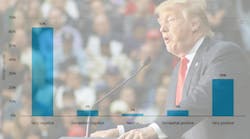Complex Challenge
As the focus of the federal Clean Water Act has shifted in the last 35 years from wastewater to storm water, airports have found themselves on the leading edge of that evolution. Discharge permits have become more restrictive, complicated and expensive to maintain. Facilities that make the effort to go beyond mere compliance sometimes are frustrated with how hard it is to predict the next phase in the growing focus on storm water.
NPDES
Section 402 of the Clean Water Act is the familiar National Pollutant Discharge Elimination System (NPDES) with its discharge permits. Unlike the act’s regulation of wastewater, which was full-fledged at regulatory inception, the regulation of pollution from storm water runoff lay dormant for many years but now has evolved to the point of storm water permits so complex that an ordinary wastewater discharge permit seems rudimentary by comparison.
Some airports saw the vanguard of newfound attention to storm water in the 1990s, in part because of citizens’ suits challenging the discharge of deicing chemicals that mix with rain and snow runoff. The initial emphasis, predictably, was control and enforcement through NPDES permits that were written as if the presence of deicing materials turned storm water into process wastewater. Nevertheless, large areas of impervious surface at airports, heavily used by airplanes and vehicles, pose a classic storm water problem. Yet even today, some airports have no permit for the discharge of storm water or deicing runoff. If storm water is carried by a drain, pipe or outfall to waters of the U.S., no permit means an ongoing violation of the Clean Water Act, especially if the airport conducts any deicing or anti-icing.
Some facilities that had grown comfortable with maintaining an NPDES permit and thought they were adequately covered began in the mid-1990s to see the impact on their permits from the total maximum daily load (TMDL) program. Section 303(d) of the Clean Water Act, requiring states to identify water quality impaired surface waters, had received little attention for many years. Again, citizen suits pushed states into the recognition that Section 303 also required states to quantify the maximum amount of the pollutant of concern, from any source, that the water quality limited stream could receive without exceeding state water quality standards. The next step in the TMDL process is for the state to allocate shares (waste load allocation or WLA) attributable to each regulated and unregulated source—including natural sources—with the sum not exceeding the TMDL. The TMDL and WLA calculations can be an incredibly difficult and complex undertaking.
Airports discharging storm water to water for which a TMDL has been set can experience sticker shock at the relatively skimpy WLA they may receive, which is then incorporated into their NPDES permit either in place of or in addition to older numeric limits. When deicing material mixes with the storm water discharge, the real difference in a permit with a WLA becomes apparent—especially where a TMDL has been set for five-day biological oxygen demand (BOD). A stream that is water quality limited for BOD may have many factors besides deicing chemicals that deplete the level of oxygen, some or most of which may be naturally occurring. Yet the regulatory focus will be on the airport because that can be controlled with the expenditure of funds. Again, this story may sound foreign to some facilities, but if that is because they are located in a state that lags in identifying Section 303(d) water quality limited streams and in setting TMDLs for them, that is likely to change. Citizen suits aside, new rules in 2000 provided for implementation plans to ensure the TMDLs and WLAs are established and enforced.
MS4 program
Some airports have faced yet another major component of the growing regulatory attention to storm water and non-point sources—the Municipal Separate Storm Sewer System (MS4) program. In the 1987 Clean Water Act amendments, Congress wanted the Environmental Protection Agency (EPA) to address non-point source pollution from storm water runoff in urban areas where the water picks up oils, grease, solvents and other problematic pollutants. However, jurisdiction under the Clean Water Act depends on discharge from a point source. Thus, the EPA determined that storm water qualified by using the rationale that eventually it must be conveyed and reach a physical point of discharge to waters of the U.S.
The MS4 program covers municipal storm water drainage systems, including roads, catch basins, gutters, ditches, storm drains and the like. Some airports probably did not take particular note of the MS4 program initially because the first phase applied to larger municipalities. Many have since learned that if airport property includes a storm sewer system that connects to or forms part of a larger municipal system, MS4 permit coverage may be necessary, perhaps as co-permittee with the municipality. MS4 permits greatly achieve reductions in discharges to the “maximum extent practicable.” How that standard may apply to an individual situation is difficult to predict with any certainty, as is the question of how it may be integrated (if at all) with an airport’s existing NPDES permit.
For deicing and Clean Water Act enforcement, airports fall into three categories: no permit whatsoever, an NDPES permit with no deicing-specific provisions or an NDPES permit that addresses deicing specifically. Those in the first category are exposed to potential enforcement liability. The others continue to be challenged on a daily basis to deal with an increasingly complex and expensive regulatory climate that frequently struggles to recognize the unique circumstances of each facility—weather, geography, operating restrictions, facility layout and staffing, just to name a few.
Author’s note: This article was adapted from a presentation given in August 2006 to the American Association of Airport Executives.
Download: Here

